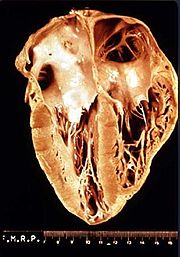by Larry
January, 2010The Kissing MenaceFor example, a type of Triatoma sp., that transmits Chagas disease, was previously found no more north than the Rio Grande Valley, which, south of the river, is in far northern Mexico and, north of it, is in far southern U.S. More recently, however, as the general warming trend has persisted and our winters have been milder (possibly also partly due to the movement northward of infected human populations, to Triatoma sp. having been transported via nursery shipments, etc.), this infection "vector" has now been sighted as far north as Fort Worth, TX.
Chagas disease is a parasitic infestation involving a protozoan, Trypanosoma cruzi, typically being carried to humans and other mammals via Triatoma sp., a variety of assassin bug that feeds on mammal blood. Since it comes out at night and often then settles on and sucks blood from sleeping people's faces, its "kissing bug" nickname seems apt. The insect can acquire the disease protozoan via the blood of another infected animal or person and then, as is true for mosquitoes, transmit the microscopic parasite when it moves on to another victim of its feeding habits. To date, there is little effective way of eradicating or controlling either the kissing bug or the disease protozoan. In areas where the kissing bug is known to be a problem, sprays and insecticide paints have been used at times. In cities, the insects hide during the day in dark, out of the way places in dwellings, so better housekeeping is helpful in the fight against them. Where the hazard is recognized in rural areas, it is best for campers to use mosquito netting at night. Another not insignificant way to contract Chagas disease is through blood transfusions. A survey in 1993 found that blood units available for transfusing patients carried the disease. The incidence ranged then from only about 1% in some Latin American countries to 48% in Bolivia. In some places, infected blood tainted up to 18% of the samples in Argentina, Brazil, and Chile. I have not been able to find the results of more recent surveys.
No vaccines are as yet effective and approved against the parasite, Trypanosoma cruzi. Antiparasite treatments can be helpful, especially if the disease is recognized early. Often, however, they do not completely eliminate the protozoan from patients' systems. Long-term effects of the disease can be severe, ultimately leading to death, most commonly as a result of heart damage. Other chronic disease effects include digestive system disturbances. These may be pronounced enough that nutrition is jeopardized. Happily, the disease progression is relatively slow. It can take decades to manifest in the more brutal ways. In fact, most of an estimated 11 million persons with Chagas disease alive today are unaware they have it. Yet it may eventually be a factor in a shorter than natural lifespan for them. No doubt as people are better educated about Chagas disease and it has a higher priority among healthcare workers and researchers, more effective means will be found to deal with this threat. Meanwhile, more needs to be known and done about Chagas disease, its spread north of the U.S. border with Mexico, and how to detect and treat its victims in the early stages. It is recommended, for instance, that blood now routinely be screened for Chagas disease, that infected donors be promptly started on treatment regimens, and that their families also be checked and begun on disease management programs as appropriate. Unfortunately, as our species comes to grips with a climate several degrees warmer than in much of its evolution and modern development, Chagas disease is but one of many new hazards from tropical areas that are likely to be heading north into the formerly more temperate parts of North America, Europe, and Asia or south into New Zealand, Australia, etc. Source: Chagas disease in Wikipedia, last updated January 12, 2010. |

